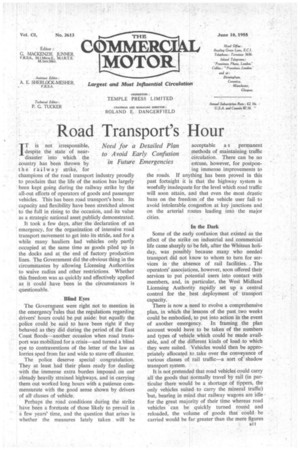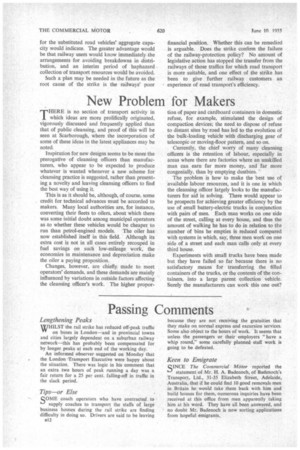Road Transport's Hour
Page 45

Page 46

If you've noticed an error in this article please click here to report it so we can fix it.
IT is not irresponsible, despite the state of neardisaster -into which the country has been thrown by the railway strike, for champions of the road transport industry proudly to proclaim that the life of the nation has largely been kept going during the railway strike by the all-out efforts of operators of goods and passenger vehicles. This has been road transport's hour. Its capacity and flexibility have been stretched almost to the full in rising to the occasion, and its value as a strategic national asset publicly demonstrated.
It took a few days, after the declaration of an emergency, for the organization of intensive road transport movement to get into its stride, and for a while many hauliers had vehicles only partly occupied at the same time as goods piled up in the docks and at the end of factory production lines. The Government did the obvious thing in the circumstances by allowing Licensing Authorities to waive radius and other restrictions. Whether this freedom was as quickly and effectively applied as it could have been in the circumstances is questionable.
Blind Eyes The Government were right not to mention in the emergency rules that the regulations regarding drivers' hours could be put aside: but equally the police could be said to have been right if they behaved as they did during the period of the East Coast floods—another occasion when road transport was mobilized for a crisis—and turned a blind eye to contraventions of the letter of the law as lorries sped from far and wide to stave off disaster.
The police deserve special congratulation. They at least had their plans ready for dealing with the immense extra burden imposed on our already heavily strained highways, and in carrying them out worked long hours with a patience commensurate with the good sense shown by drivers of allclasses of vehicle.
Perhaps the road conditions during the strike have been a foretaste of those likely to prevail in a few years' time, and the question that arises is whether the measures lately taken will be acceptable a s permanent methods of maintaining traffic circulation. There can be no excuse, however, for postponing immense improvements to the roads. If anything has been proved in this past fortnight it is that the highway system is woefully inadequate for the level which road traffic will soon attain, and that even the most drastic bans on the freedom of the vehicle user fail• to avoid intolerable congestion at key junctions and on the arterial routes leading into the major cities.
in the Dark Some of the early confusion that existed as the effect of the strike on industrial and commercial life came sharply to be felt, after the Whitsun holiday, was possibly because many who needed transport did not know to whom to turn for services in the absence of rail facilities. The operators' associations, however, soon offered their services to put potential users into contact with members, and, in particular, the West Midland Licensing Authority rapidly set up a central control for the best deployment of transport capacity.
There is now a need to evolve a comprehensive plan, in which the lessons of the past two weeks could be embodied, to put into action in the event of another emergency. In framing the plan account would have to be taken of the numbers and types of vehicle which could be made available, and of the different kinds of load to which they were suited. Vehicles would then be appropriately allocated to take over the conveyance of various classes of rail traffic—a sort of shadow transport system.
• It is not pretended that road vehicles could carry all the goods that normally travel by rail (in particular there would be a shortage of tippers, the only vehicles suited to carry the mineral traffic) 'but, bearing in mind that railway wagons are idle for the great majority of their time whereas road vehicles can be quickly turned round and reloaded, the volume of goods that could be carried would be far greater than the mere figures for the substituted road vehicles' aggregate capacity would indicate. The greater advantage would be that railway users would know immediately the arrangements for avoiding breakdowns in distribution, and an interim period of haphazard collection of transport resources would be avoided.
Such a plan may be needed in the future as the root cause of the strike is the railways' poor financial position. Whether this can be remedied is arguable. Does the strike confirm the failure of the railway-protection policy? No amount of legislative action has stopped the transfer from the railways of those traffics for which road transport is more suitable, and one effect of the strike has been to give further railway customers an experience of road transport's efficiency.




























































































































































